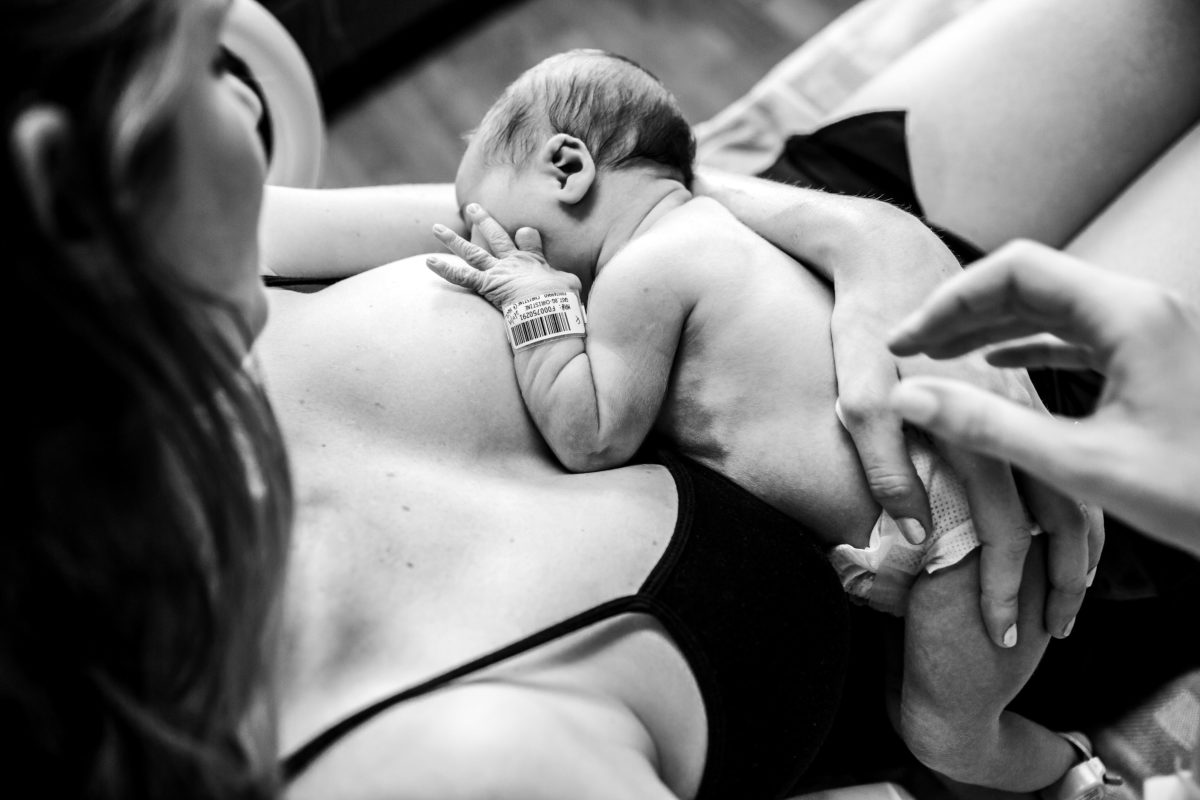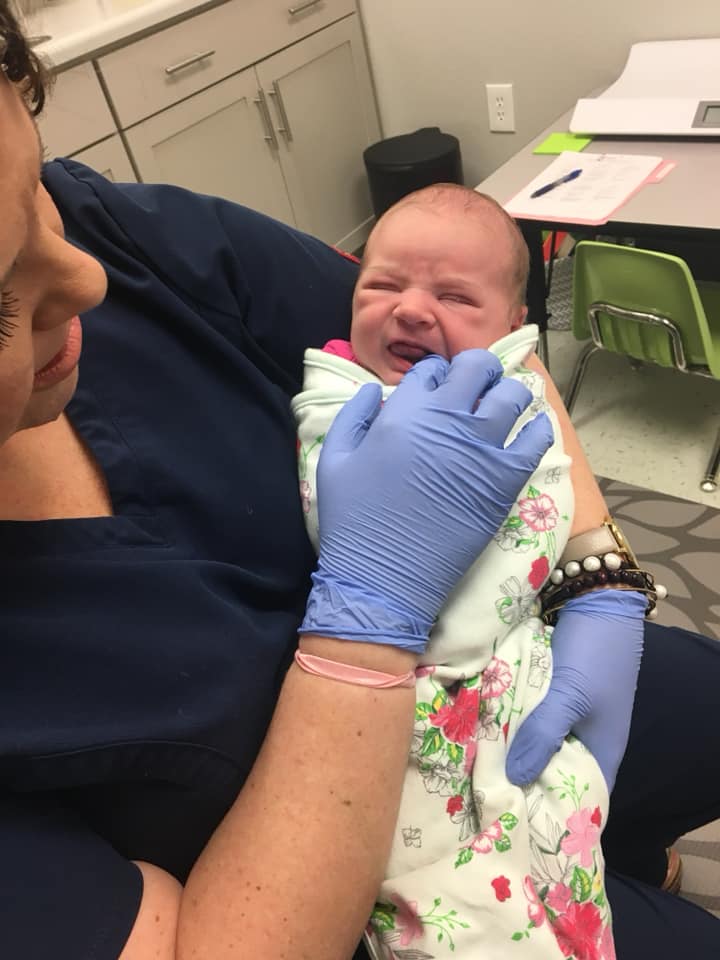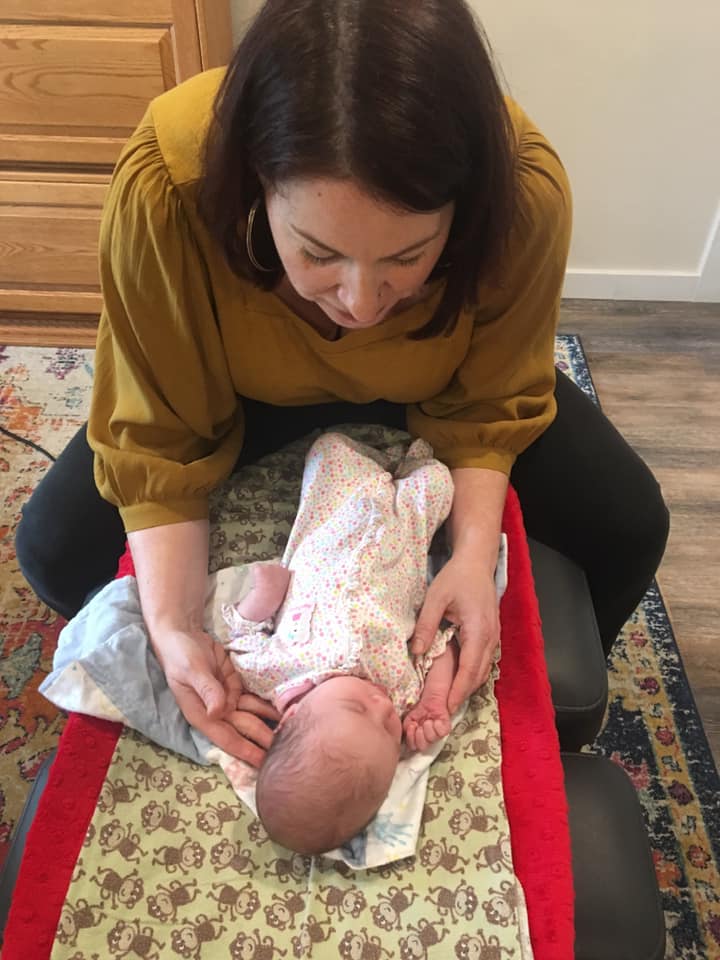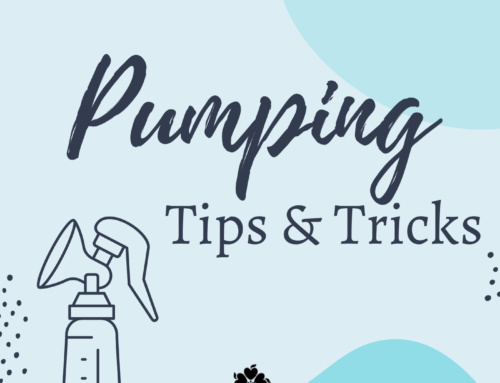.
Before I gave birth, I wrote a blog post about how I was mentally preparing to breastfeed my very first baby – Audrey Ann, as an IBCLC lactation consultant. Well after breastfeeding her these past several weeks, I figured I’d let you know about our breastfeeding journey, and how we overcame our breastfeeding struggles. I also want to provide some advice and words of encouragement to new moms and those already breastfeeding.
I will say, how happy I am to have the knowledge I have as an IBCLC lactation consultant. But just because I know a lot, doesn’t mean I didn’t encounter trials… I just knew how to navigate it. My Breastfeeding 101 video, covers a lot of what you need to know about breastfeeding and is a good stepping stone.
Baby girl and I definitely had some bumps, as I’m sure every breastfeeding mom and baby have. We experienced difficulty latching, vasospasm, pinched nipples, posterior tongue tie, engorgement, and almost cracked nipples. I will be sharing my journey in a two part series. This post is my overall take away with breastfeeding, and my second post will be exactly how we overcame each trial. I hope to provide you with tips and recommendations to help in your breastfeeding journey or at least prepare you. If you need one on one breastfeeding support, please do not hesitate to reach out to either myself, or someone in your local community.

.
Breastfeeding takes patience
There were two distinct times where I really had to practice patience. The initial latch in the hospital, then the latch once my milk came in. There are definitely other times where I have had to practice patience, but these two distinct times are important to be mindful of for new moms.

.
Initial Latch
The first was the initial latch at the hospital. I went into it knowing it was going to take time. I knew she wasn’t going to get it right away, so the best thing to do is remain calm and be patient. As frustrating as it can be, remain calm. When she started to get frustrated, I brought her up to my chest and “shh’d” her, then attempted again. Thankfully it actually didn’t take as long as I anticipated. It took about 10 minutes, but then once she latched it was good.
Tips for that initial latch
1.Stay calm
Take deep breaths and just know this can take some time
2. Sit on the couch if you’re having a hard time latching in the hospital bed
I found having my feet on the floor and stabilized and me sitting up but slightly leaning back helped me see and have more control
3. Hold your baby in the CROSS CRADLE hold
In this position, you have full control of your breast, and full control of your baby’s head. In this hold you can better navigate the two. Please do not try to attempt the very first latch in a CRADLE hold, where your baby’s head is in the nook of your elbow. I know they show it in movies, and I even have some photos of me and my baby in that hold, but that hold is for after you’ve got the latch figured out. Use the CROSS CRADLE when you’re starting out, or even the FOOTBALL hold.
This is me in the hospital working on our very first latch. I’m sitting on the couch in my room where I am well supported with my feet on the floor. There are no bed side rails that are preventing me from spreading my arms out or hitting my baby’s legs. This is what worked for me and my baby
.
Engorgement
The second part of patience was when my milk came in at 4 days postpartum. Whether you plan to breastfeed or not, your copious amount of milk will come in typically around 3-4 days postpartum, but some women it might take longer; it’s called delayed lactogenesis.
Breastfeeding was going great the first 3 days, except for the pain, which I’ll go over in the next section. But once my milk “came in” at 4 days, where my body started to make copious milk, I felt so engorged! I remember waking up in the middle of the night thinking “oh no! The engorgement is here…my milk has come in…it’s going to take baby girl some time to get this…be patient…”
And sure enough, she had a hard time latching. The reason is because when you’re engorged, it makes your breast tighter and the skin less “elastic,” so it’s harder for the baby to grab on to the breast and get a latch. Also, when you’re engorged, your milk just starts flowing out and it makes the nipple slippery and once again hard to latch on to.

.
Tips for latching when engorged
1.Be patient and remain calm
Baby will be frustrated she can’t latch, and you’ll be frustrated she’s not latching, so be patient and calm. This will be especially hard for you to remain patient and calm in the middle of the night when you’re tired, but this is typically when you’re most engorged. If you can mentally prepare yourself, you’ll have a better time navigating it
2. Hand express to relieve that engorgement and tightness
Get a burp cloth and hand express into it, or get a manual pump and just do a couple strokes to relieve that pressure. I used a burp cloth and did this, but honestly my baby was just too hungry and fussy for me to spend the next 5 minutes hand expressing, so we just worked on her latching when I was engorged, and she caught on.
3. Keep a burp cloth near by
When you’re engorged, there is so much milk, that it will be spilling out (at least in my case), that it will make your nipple and breast very slippery and hard for your baby to latch on to. Keep a burp cloth near by and keep drying your breast. Dry your baby’s mouth and dry your breast, and try to latch again.
4. Find a position that works
Just as you’ve mastered that initial latch with a certain position, you might have to find a new position, as you’re now navigating the engorgement stage. For us, we went against typical recommendations, which is the laid back position since gravity helps control the flow and found our own position. The typical recommendation for engorgement and a fast flow, is the laid back position. This position prevents gravity from causing a faster flow.
However for us, she kept unlatching and getting frustrated in the laid back position. I tried every possible position, but found a random position that seemed to work. I laid her down on the bed, and leaned over her and basically shoved my breast in her face (it sounds horrible, but it seemed to work). Her eyes would get super big and you’d just hear chug chug chug! Poor girl, but you gotta do what you gotta do. It wasn’t very comfortable for me, but hey, any way to get her to drink and for my breasts to soften and not feel so engorged, was a win for me.

This is the position that my baby and I found that worked for us when I was engorged. It’s not your typical position, but it worked. Find a position that will work for you – it doesn’t have to be a “textbook” position.
.
Breastfeeding is painful
Now there are two TYPES of pain and they are important to differentiate. There is the toe curling/lip biting, “get this baby off of me” pain, or the typical pain, which is tolerable but not very comfortable and somewhat hurts.
Breastfeeding is NOT supposed to be toe curling, lip biting, painful. But your nipples are very sensitive, especially if this is your first baby like me, so you will have some pain, because your nipples are being pulled and tugged for the first time.
In my specific case, I had the lip biting, toe curling pain. I’ll be writing a separate blog post to explain why, and what we did to overcome this, since it’s pretty lengthy with my tips and tricks. But my baby ended up having a posterior tongue tie, as well as a lot of tension from delivery (you can read about my birth story and see why). She was clenching and biting every time, and wasn’t sucking properly. This was giving me all the pain.
But to give expectant moms a heads up – yes you will have some pain, especially that initial latch due to your nipples being tugged and pulled on. Some tugging pain is normal, until your nipples get used to the tug and pull. I usually recommend counting to 10, and if after 10 seconds you’re still having pain, then reassess the latch and positioning. If it’s continual pain, then seek help from an IBCLC lactation consultant (check out this post to see the difference between the different credentials of lactation consultants).

.
Breastfeeding is a job
It’s funny because I always told my clients that breastfeeding is a lot of work, it’s like a full time job, and man it really is! Babies have small stomachs, and breastmilk is 100% digestible, so they’re going to get hungry often, which means you’re going to be nursing often. You’re going to say to yourself “How can you be hungry?! I JUST fed you 45mins ago!” You’re emotionally drained, you’re physically tired, the last thing you want to do is nurse, but you’re the only one that can do this. No one else can nurse your baby for you.
There were probably one or two times, I just emotionally couldn’t do it, and I asked my husband to give her a bottle of my pumped milk, while I took an Epsom salt bath and just spent me time. I was emotionally drained and I remember just crying in the bath tub saying how much I hated this work, and how I just wish my husband could nurse her. FYI you will cry a lot in the beginning – all those crazy hormones. I need to write a post just about mental health postpartum because it’s so complex! But girl just cry! Let those tears out! It feels good to cry.
.
So yes the beginning is a lot of work, but it is the MOST important time for establishing breastfeeding. The hard work in the beginning, makes the job much easier later on, so you really have to stick it out. Ask for help! Get your husband to help around the house, make meals, and if necessary, give a bottle of pumped milk when you need it, for your own sanity. Also encourage your partner to find their own ways to soothe baby, because not all crying and fussiness means hunger. I loved watching my husband find his touch and way of soothing her without a bottle or pacifier.

.
Push through the first 4-6 weeks
Give yourself 4-6 weeks or longer of breastfeeding before deciding to throw in the towel! The first couple weeks are rough, especially if breastfeeding is painful. It’s A LOT of work in the beginning. Not only are you tired and just wanting to sleep and veg, but you’re having to nurse every couple hours, sometimes every 30 minutes.
It’s hard and it’s emotional. You won’t enjoy it, but hang in there! It will get better! Remember your WHY for breastfeeding? Get over that mountain. Once you’re over that mountain, there is a beautiful valley and you will enjoy it.

.
Utilize your local resources
I can’t stress this one enough! Know your local resources! Know who your local lactation consultants are, the infant chiropractors, maybe even speech pathologists. Whatever bumps you may have, get professional help. I will encourage you to find these professionals BEFORE you deliver, so you know who to contact ASAP.
I am blessed to be surrounded by a great birthing community here in Florida. We saw a lactation consultant! Yes a lactation consultant saw a lactation consultant, and this is because I wanted to be my baby’s mom and I also wanted to get a second opinion on things. Everything she told me, is what I would’ve told my clients. It was nice to get that affirmation from someone else. We saw an infant chiropractor that practices craniosacral therapy (CST). I took my baby to her when she was only 4 days old! She could tell right away where the tension was in baby’s jaw and why she was clenching on the breast. We continued seeing her once a week for about a month.
We also saw a speech pathologist, that works with infants and suck training. She was able to assess where my baby had oral tightness and was able to strengthen my baby’s tongue movement and suck. She taught me suck training exercises to do at home with my baby to help speed up the process. (I had been teaching moms certain suck exercises, but it was cool to learn more exercises by a speech pathologist). We saw her once a week for about one month as well.
Between the chiropractor and the speech pathologist, breastfeeding SIGNIFICANTLY improved! We ended up not even getting the posterior tongue tie released, because I felt that just between the two of them, they had released so much oral tension and taught my baby how to properly suck, that I didn’t think the release was necessary. They also agreed that they didn’t think it was necessary, so it was comforting to know that they also agreed we didn’t need to get it done. There are definitely cases where I recommend a tongue tie release, but it really is a case by case situation.
.
It won’t feel like a special bond at first
Those first couple weeks, when it’s rough and you’re trying to figure it out, you’re not going to feel that special bond that everyone talks about…that does come later, though 😉 So don’t have that expectation or tell yourself, you’re not doing things right, because you don’t feel that bond.
It’s okay to not like breastfeeding
It’s okay to not like breastfeeding. I admit, I did not like it at first! If I didn’t know what I know, and if I wasn’t such a huge breastfeeding advocate, I might’ve quit, and I hate thinking about that. I didn’t feel that bond until around 3-4 weeks, maybe even week 5. I now LOVE it!
So it’s okay to not like it! It’s a lot of work and a lot of stress and emotions. Add all that to an already tired mom who’s trying to recover from birth and pregnancy. And what if you have older kids you also have to care for! Man, yeah breastfeeding is work and you will not enjoy it!
But that’s okay! Remember to go back to your WHY you want to breastfeed, and find the support to get you there.

I’ve learned to master breastfeeding while standing up, which helps if baby has a good latch and suction. It also helps when they’re not super heavy or big, as she is now ;(
.
My take away
Breastfeeding is hard, it’s work, it’s tiring, but the benefits and the reward if you can stick it out, is so wonderful!
Mothers: it’s okay to not like it and not feel that bond right away. There’s nothing wrong with you. Please find support whether it’s from a lactation consultant, friends, family that have breastfed, or a breastfeeding support group. The more people you have in your tribe, the more support you have and the more motivation you’ll have to carry on with breastfeeding. It does get better!
It took me about 3-4, maybe 5 weeks to get the hang of it and start to love it. It’s so convenient! I don’t have to prep any bottles, or get out of bed in the middle of the night to feed her. I love looking at her, as she’s on my breast. Her bright blue eyes, and it’s all because I stuck out the storm. You can too! It will get better!
I’d love to hear from you in the comments. What was your experience like? How long did it take you to get out of that storm and feel comfortable with it?







